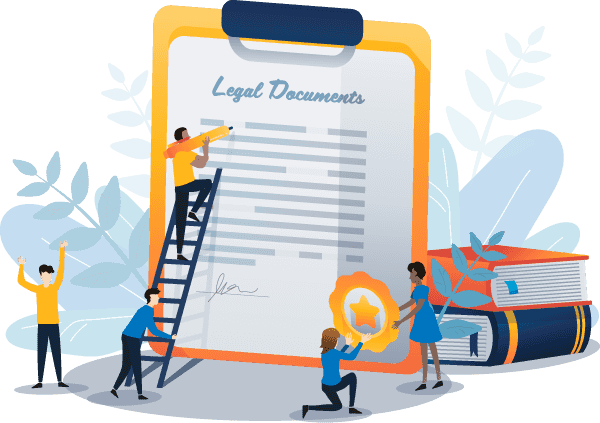Employees struggling with their mental health are becoming more prevalent in the workplace. Now 1 in 5 Australians will experience mental illness every year. It is important for employers to stay vigilant on how they can adapt the workplace to prevent harm to their employees’ wellbeing. In fact, Work Health and Safety legislation make it an obligation for employers to do so. Stay attentive to how your employees are coping with work. Australian businesses face costs of $10 Billion each year in stress-related workers compensation claims.
By reading this article, you can learn how to ease the risk of your employees experiencing mental illness. Through building the wellbeing of your employees, you may also see higher performance in the workplace. Not everyone works best under pressure.

Protect your business and customise your WHS Policy for free.
Create and download our Work Health and Safety Policy.
Get startedWhat is Mental Illness?
A mental illness is “a health issue that can significantly affect how a person feels, thinks, behaves and interacts with other people”. Most commonly, mental illness will present itself through mood disorders, like depression, or anxiety disorders. Society’s perception of mental illness is often focused on how a person feels. However, mental illness can also affect how a person behaves and thinks. If you have noticed a drastic change in an employee’s performance at work, this may be a sign that they are affected by a mental illness. Like any other health issue, however, mental health is treatable.
Now let us look at how you can change the workplace to improve employee wellbeing.
Identify Hazards
Like physical hazards in the workplace, employers have an obligation to reduce risk of injury. When it comes to employee wellbeing, what you are reducing is risk of mental illness. Think about whether the workplace is an environment that supports employee wellbeing or is it one that causes poor mental health.
Three clear hazards in the workplace that can cause risk to employee wellbeing are stress, bullying and harassment. Stress is commonly associated with any job but there are several factors that can elevate stress to unhealthy levels. Identify whether your employee:
- Is overloaded with work
- Does not have support from their co-workers
- Or lacks recognition for their accomplishments
Bullying and harassment can severely impact the wellbeing of your employees. If you are unsure what bullying looks like in the workplace, we have helpful articles on how to identify bullying and how to respond appropriately.
Make Reasonable Adjustments
Workplaces can consist of high pressure environments that impact employee wellbeing by piling on stress. Making reasonable adjustments to an employees workload can dramatically reduce the pressure they are under. To achieve this, you could:
- Discuss with your employee flexible work hours
- Extend deadlines where possible
- Or simply break down a project into smaller tasks.
In discussions, ask your employee what barriers they have to completing work and design the adjustments as solutions to those challenges.
Keep in mind that a reasonable adjustment does not mean the core requirements of the role disappear. The purpose of reasonable adjustments is ensuring an employees duties can be accomplished without jeopardising their wellbeing.
For more information on Reasonable Adjustments, refer to https://humanrights.gov.au.
Reduce Stigma About Mental Health
It is difficult for employees to discuss mental health when they believe their workplace views mental illness as a weakness. It is critical employees know that mental health is no different than any other health related issue. If you have a cold, you can go see your local GP. Mental health works in the exact same way. If employees are aware that having mental health issues is normal, this can lessen the added burden of hiding their struggles to maintain their reputation in the workplace. As an employer, you can help reduce stigmas around mental health by spreading awareness to your team that mental health is nothing to be ashamed of.
Stay Educated
To best help your employees, be pro-active and educate yourself on mental health. If your employee approaches you with a mental health issue, it is important to know how to support them. A great skill to learn is how to talk to employees about mental health. You want to make sure they are comfortable and feel safe. You do not have to diagnose them, just listen and let them know there are professionals who can help. However, not all employees will approach you. It is also beneficial to know what the signs are of someone experiencing a mental health issue. If you are unsure where to start learning more about mental health, SafeGov Australia has programs to educate employers.
Stay Dedicated
Let your employees know that you are there to support them through mental illness and to encourage the growth of their wellbeing. Bringing it up in a meeting is a great way to do this, but it is only the first step. Communicate with your team leaders to ensure employee wellbeing is their priority and encourage them to communicate that with their teams often. You can also have posters in the workplace that advertise various hotlines employees can call if they are struggling with mental illness. Furthermore, update your WHS policy to reflect your value of your employees’ wellbeing.
Conclusion
By creating an environment that supports the wellbeing of your employees, you will be creating a workplace that allows staff to perform at their best. Remember your responsibility to look out for any hazards to mental health in your workplace. If your employees are overloaded with stress, make reasonable adjustments so they can do their job well. In addition, spread awareness that mental issues are nothing to be ashamed of. Overall, the best way to achieve an environment that improves employee wellbeing is to stay educated on mental health and keep your staff dedicated to keeping it a priority.




